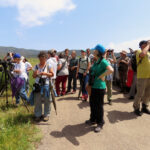
‘Thousands of tonnes of nuclear waste were dumped by the Soviet Union in the Artic Ocean from 1964 to 1986. As the barrels, which were prepared to be watertight, did not sink, the soldiers were ordered to pierce them with shots’ ndrei Zolotkov (Russian nuclear expert).
In March 2012, a non-legislative motion of the Mixed Group called on the Spanish Government to inform Congress and the Galician Government of the evolution of radioactive waste from the Atlantic Trench. The answer was that the necessary controls were already being carried out by the Nuclear Safety Council. They were asked not to frighten people with unfounded concerns.
The fact is that the status and the corrosion level of the barrels containing nuclear waste, which were dumped in the oceanic trench of the Atlantic Ocean until 1983, is currently unknown. The waste, which was stored in steel containers enveloped in concrete, is resting at a depth of about 3000 metres, subjected to enormous pressure. Thus, in the event of an accident, there would be no technique that would allow their recovery. Even the International Atomic Energy Agency (IAEA) is not able to determine accurately how much radioactive waste was dumped into the oceans and the state in which such barrels were found since they were not watertight as they were supposed to be. Also, they could not evaluate the significance of its effect over the marine environment and its inhabitants.
Since the 1960s, several countries with nuclear power plants produce electricity causing the waste generated to become a problem and that the sea be transformed into a big landfill, despite the London Convention of 1972 having prohibited dumping high-level radioactive waste into the sea. Low-level and medium-level waste was not discussed. The Atlantic trench or Hercules trench was one of the chosen points. It was about 700 km from the Galician coast and about 4000 m deep. From 1967 to 1983, 142000 tonnes of nuclear waste arrived from eight “civilised” European countries.
The first protests began timidly and were led by environmental groups. In 1970, Cousteau presented to the Council of Europe photographs of barrels in a worrying state. Later, Greenpeace, who had been fighting at sea since 1978 against this type of waste would film that reality. These advocates faced rejections, especially from people in coastal towns, who started demonstrations against them.
However, the first expedition in Galicia against nuclear waste in the Atlantic Trench was an initiative of the political party Galician Left, who contacted Greenpeace to propose them a maritime expedition to the Atlantic trench. Eventually it took place in 1981 involving representatives of the political party from Vigo, A Coruña and Moaña municipalities.
They chartered a longliner made of wood named Xurelo. It was 20 meters in length and 69 tons in gross tonnage had been used until then was used to catch hake. His skipper Ánxel Vila, a fisherman from Aguiño, took the boat in hopes of a memorable trip with 14 people on board. In addition to the organizers and four crew members, there were journalists and photographers such as Manuel Rivas, Xosé Castro and Xurxo Lobato, Gallego, Xesús Noya and the ecologists Roxelio Pérez Moreira of the collective Natureza and our SGHN colleague Enrique Álvarez Escudero (also known as Quique).
On 14 September 1981, Xurelo left Ribeira with a team that was not legally enrolled and received warnings from the maritime authorities. The protest had been jointly planned with Sirius, a Greenpeace vesseel. However, this ship broke down in the port of Plymouth, so the Galician expedition travelled alone. Enrique Álvarez’s accounts allow us to guess the extreme fragility of the boat and the inexperience of the peoplein board, despite having enthusiasm and courage. They sailed with scarce technical resources and the sole support of the Fisterra and Vigo coastal radio stations. They went to a place in the Atlantic, where two Dutch ships (Louise and Kristen), defended by a frigate of the Dutch Navy, were dumping cans with nuclear waste into a wooden boat. This was masterfully conducted by a great seafarer who was aware of the damage that the waste were to cause in the marine environment.

O Xurelo na Fosa Atlántica 
During almost a week at sea, Xurelo broadcast a message in several languages as if it were a flag. In this way, every boat that approached them was addressed and asked to join them in order to go to the place where the radioactive waste was being dumped. ‘We came in the name of Galicia, we came on behalf of every person who wanst a peace and a progress that do not destroy nature. We came in our own name and on behalf of all future generations. The Atlantic Ocean is a source of wealth and a horizon of communication, we do not want them to turn the Atlantic into a nuclear cemetery. The Atlantic is a symbol of Galician identity and a symbol of life for all peoples. We don’t want them to convert it in a symbol of death.’
And finally, they located the ships pouring deadly cargo. There, being helpless witnesses of what was happening, they sounded the sirens of Xurelo as they stood between the two great ships. They took visual documents of what was happening, thus obtaining images of the waste that was spreading throughout Europe. There, being helpless witnesses of what was happening, they sounded the sirens of Xurelo as they stood between the two great ships. They took visual documents of what was happening, thus obtaining images of the waste that was spreading throughout Europe.
Xurelo sank in November 2002, while the Prestige disaster ravaged the Galician shores, leaving behind that trip of a large human group on a small boat, who succeeded in bringing together a large part of the Galician population who had not noticed the importance of what was happening a few miles from their land: the cessation of radioactive waste dumping. In the summer of 1982, there was a second expedition in which, besides Xurelo, the ships Sirius, Arousa and Pleamar participated. There tried to prevent the Dutch vessel Scheldeborg from dumping the barrels into the sea.
At the same time, demonstrations against the marine nuclear cemetery were repeated in Galician coastal towns and cities. They were human concentrations with a very high participation in which the SGHN was very active. The awareness of Galician people was ahead of Spanish politicians. This helped Spain in its rejection of to keep receiving nuclear waste near the Galician coast in the London Convention on February 1983. This decision did not bind those other countries that keep depositing radioactive waste in oceanic trenches.
Environmental associations such as SGHN, Federación de Amigos da Terra, and ADEGA keep on protesting and urging the Spanish Government to call for the suspension of waste dumping. In the summer of that same year, British trade unions showed solidarity with the Galician people by preventing shipments of radioactive waste when the United Kingdom intended to add plutonium and bury polluting barrels in the seabed. Should this be the case, they would violate two international standards on marine pollution: dumping highly radioactive waste and burying it at the bottom of the sea. Those two possible crimes were the basis of a new fight to stop new waste and spillage.
These actions led to the adoption of a moratorium in February 1983. Henceforth, dumping toxic nuclear waste in the sea was banned as long as the necessary studies were not carried out to evaluate the consequences. Finally, in 1993, international provisions were adopted forbidding the deposition of high-level waste in the sea. Unfortunately, despite this, the use of ocean trenches as a landfill is currently under consideration in some parts offer the world.
Text translated by Sergio Méndez Fernández (student of the Degree of Translation and Interpretation of the University of Vigo)






